
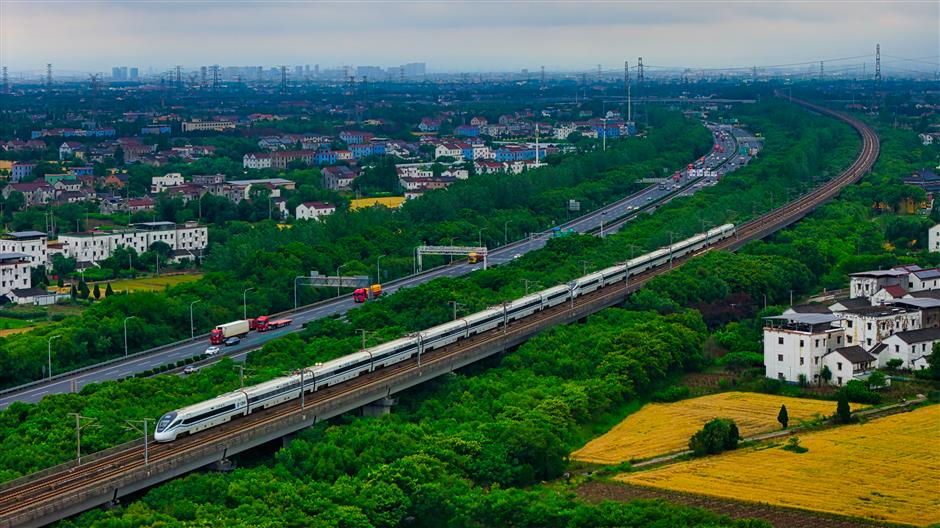
An important part of the Shanghai-Suzhou-Jiaxing Intercity Railway, the Jiangsu section of the Water Town Tourism Line started construction recently, stringing a cluster of Jiangnan water towns.
Jiangnan refers to regions to the south of the lower reaches of the Yangtze River.
The intercity railway is a landmark project to promote the interconnection of infrastructure in the Yangtze River Delta Ecology and Greenery Integration Demonstration Zone, including the Shanghai Demonstration Line in Shanghai, the Water Town Tourism Line in Jiangsu, and the Jiashan-Xitang Line and Jiaxing-Fengnan Line in Zhejiang.
Among them, the Water Town Tourism Line is an important cross-provincial transportation infrastructure project connecting Shanghai, Jiangsu, and Zhejiang.
The line starts from the Watertown Parlor Station in the demonstration zone, passes through Wujiang, Huzhou, Wuzhen, and Yanguan, and finally reaches Hangzhou Xiaoshan Airport, a total length of 132 kilometers.
It strings a cluster of Jiangnan water towns in the demonstration zone such as Zhenze, Lili, and Tongli, as well as surrounding Yanguan, Lianshi, Wuzhen, and Nanxun. It covers more than 20 scenic spots above 4A level along the way, connecting many important cities in the Jiangnan region.
The designed speed of the tourism line is 160 kilometers per hour.
The Jiangsu section of the project starts from the Shanghai-Jiangsu boundary and ends at Bache Station, with a total length of 27.314 kilometers. It sets up three stations, Fenhu Station, Suzhou South Station, and Bache Station, with a total construction period of four years.
Already expecting the operation of the Water Town Tourism Line? We preview some water towns dotted along the line and their tourism splendor.
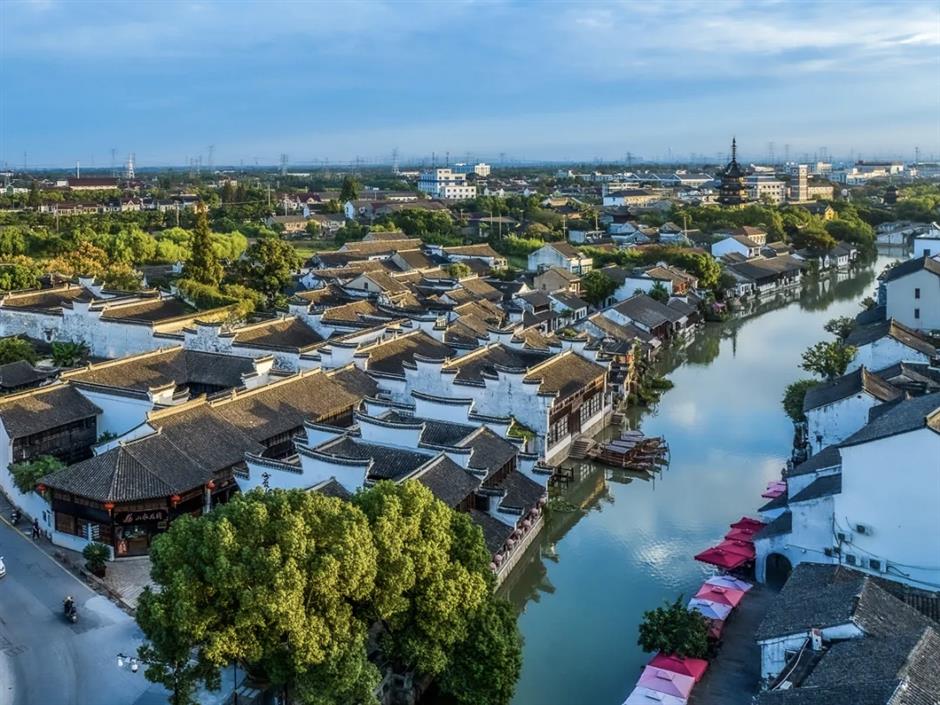
A view of Zhenze.
Zhenze 震泽
Zhenze Town, bordering Nanxun to the west and leaning against Taihu Lake to the north, is a renowned silk town in the Wujiang district of Suzhou in Jiangsu Province. Zhenze is one of the five major mulberry towns in Jiangnan.
The ancient town boasts enchanting scenery and a branch of the Grand Canal flows through it.
It features Ciyun Temple, built during the Xianchun period (1265–1274) of the Song Dynasty, formerly known as Guangji Temple.
From the Wanli period of the Ming Dynasty (1368-1644) to the Kangxi, Qianlong, and Daoguang reigns of the Qing Dynasty (1644-1911), halls and buildings were repeatedly expanded, making it a large Buddhist temple in Wujiang with many eminent monks in history. The temple has an ancient pagoda called Ciyun Temple Pagoda, a landmark of the temple.
Zhenze Ancient Town has numerous attractions, including Yuji Bridge built to commemorate Dayu's flood control, Ciyun Temple, Ciyun Pagoda, as well as the Qing Dynasty Shijian Hall, Wenchang Pavilion, and Folk Custom Exhibition Hall.
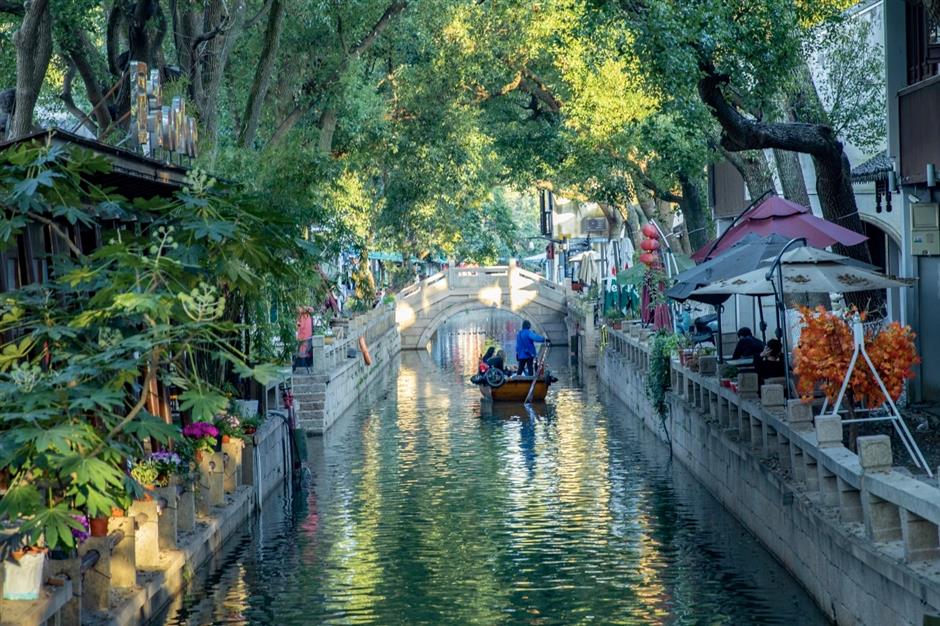
A tranquil scene in Tongli.
Tongli 同里
Tongli was founded in the Song Dynasty (960-1279). It has a profound cultural heritage and is known as a place of elegance and talent.
The scenic area is divided into seven islets by 15 crisscrossing small rivers, while 49 ancient bridges connect these islets into an integrated whole.
Tongli watertown is famous for the Tuisi Retreat and Meditation Garden, a World Cultural Heritage Site, the Mingqing Street, and Tongli National Wetland Park.
Tuisi Retreat and Meditation Garden boasts a complete range of pavilions, terraces, towers, halls, corridors, bridges, and other structures, with a pond at its center, making the buildings appear to float on water.
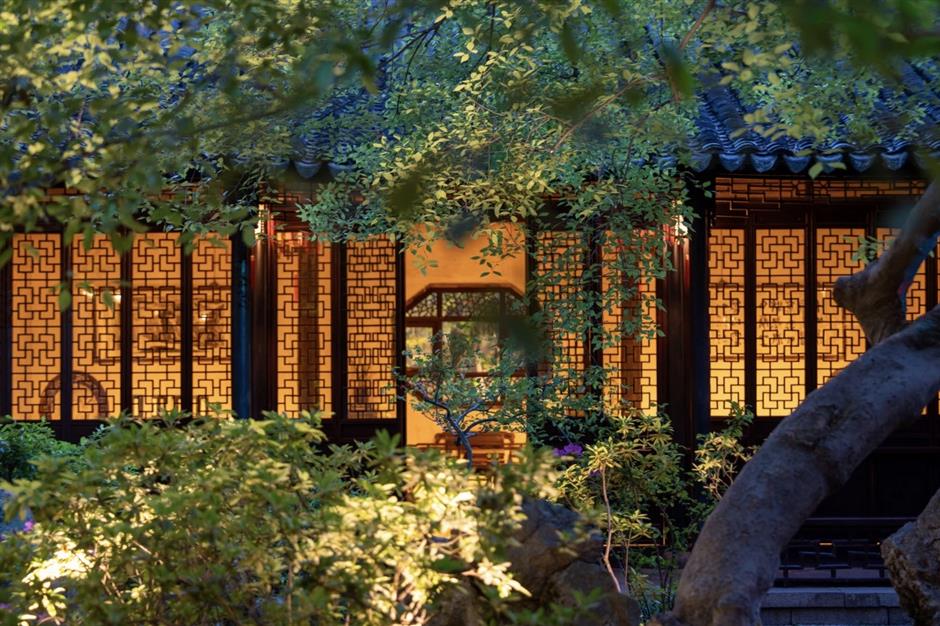
A night view of Tongli.
Tongli National Wetland Park, known as a biological paradise, has a forest area of about 4,000 acres. It is a wetland forest park that integrates forest landscape, pastoral landscape, and water network landscape.
The Three Bridges refer to Taiping Bridge, Jili Bridge, and Changqing Bridge.
Taiping Bridge is a beam-style bridge, while the other two are arch bridges.
Mingqing Street is one of the ancient town's commercial streets, about 160 meters long. In the architectural style of the Ming and Qing dynasties, it preserves the unique pattern of parallel upper and lower streets in Jiangnan. The inscription at the entrance was written by Fei Xiaotong (1910-2005), a renowned sociologist.
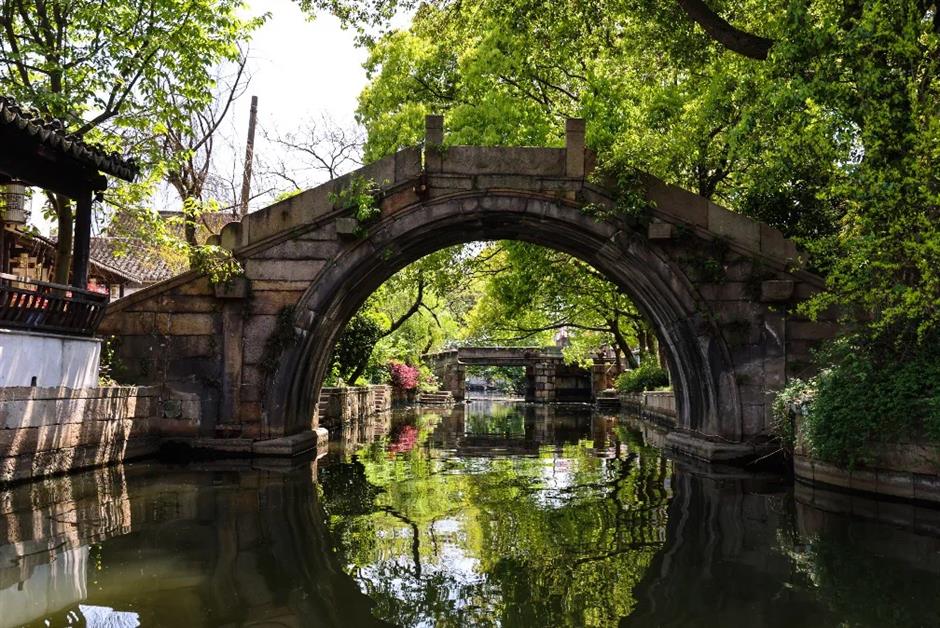
A picturesque scene in Lili.
Lili
Lili in Suzhou is a well-preserved ancient town next to Shanghai's Qingpu District, with a history going back 2,500 years and still retaining the charm of the Ming and Qing dynasties.
Lili is one of the towns which kept the authentic Jiangnan alleys, especially the "dark alleys" – as narrow as less than 1 meter wide with a roof on top and quite dark inside.
There are 115 alleys here, of which 90 are "dark." In the past, the dark alleys were used as a hallway for important families – it is said Lili had eight major families during the reign of Emperor Qianlong (1711-1799) and Jiaqing (1760-1820), each of which had at least one alley named for them.
Over 200 years later, descendants of the families still live in these alleys.
Walking along the over 4,000-meter-long historic river bank left by the Ming and Qing dynasties, the 256 wharves and 352 carved stones used to rope the boat cable tell the stories of a once thriving water town.
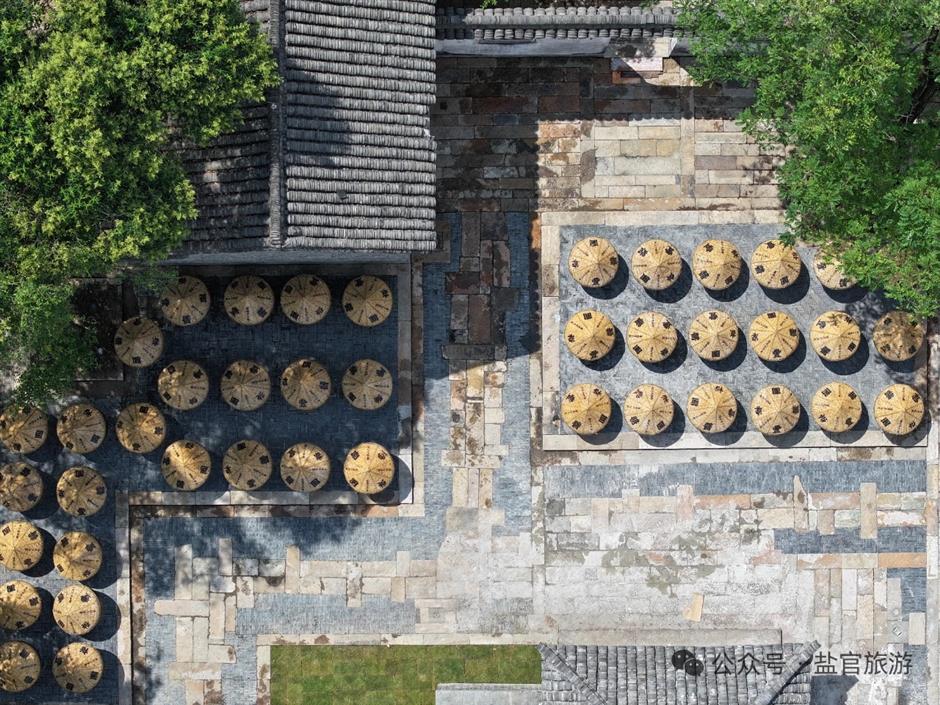
A bird's-eye view of Yanguan.
Yanguan 盐官
Yanguan Ancient Town, 50 kilometers from Hangzhou, is closely connected with the tide. Every year on the 18th day of the eighth lunar month, the tide is surfing here, galloping like thousands of horses, and the scene is spectacular.
However, the town's charm goes far beyond that.
It is a famous historical and cultural town in China. In the Western Han Dynasty 2,200 years ago, Liu Bi, the King of Wu, appointed an official in charge of salt, and the place was named after the official.
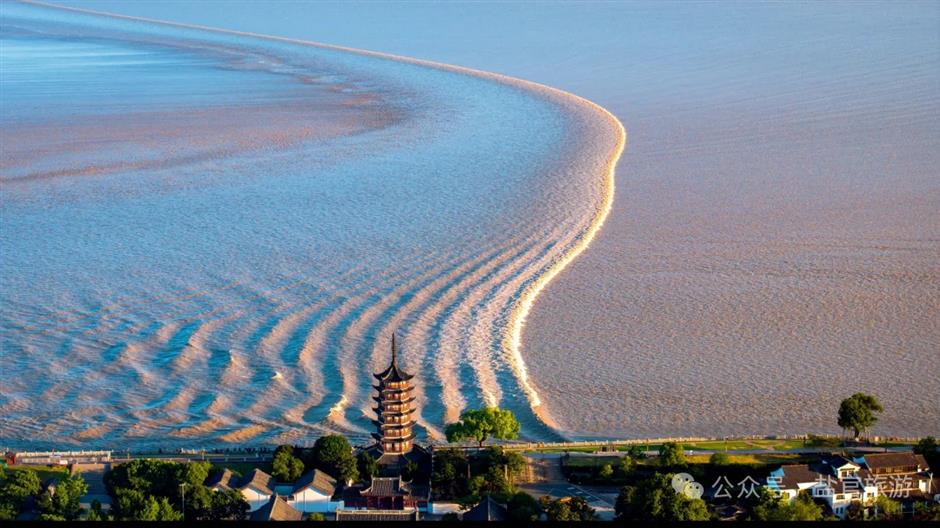
Yanguan is known for its tide.
Combining natural scenery and historical and cultural landscapes, Yanguan Ancient Town attracts many tourists.
The ancient buildings of the Ming and Qing Dynasties are hidden surprises. The former residence of Chen Yuanlong, governor of Guangxi, which received Emperor Qianlong four times, still exudes the noble atmosphere of a big family in the past.
The former residence of Li Shishi, a courtesan in the Northern Song Dynasty (960-1127), is a silent witness to history. Between the blue bricks and black tiles, it seems that one can hear the breath of history, telling those past stories of elegance and uniqueness.

Sunshine filters Wuzhen.
Wuzhen 乌镇
The cross-shaped inland water system divides the town into four blocks: east, south, west, and north, known as Dongzha, Nanzha, Xizha, and Beizha, with a total area of 79 square kilometers.
It is a typical Jiangnan water town, known as the "land of fish and rice and home of silk." Wuzhen features streets along rivers, connected by bridges, with houses built by the water, over-street arcades, bamboo stone railings, and riverside pavilions.
It preserves a large number of Ming and Qing dynasty Jiangnan water town dwellings, such as the Jiangnan Woodcarving Exhibition Hall, Xiuzhen Temple Ancient Stage, Huiyuan Pawnshop, and Zhaoming Academy, and main attractions like the Wuzhen Folk Custom Hall, Jiangnan Hundred Beds Hall, Traditional Workshop Area, Xiangshan Hall, and Fengyuan Twin Bridges, completely retaining the original style and pattern of a water town.
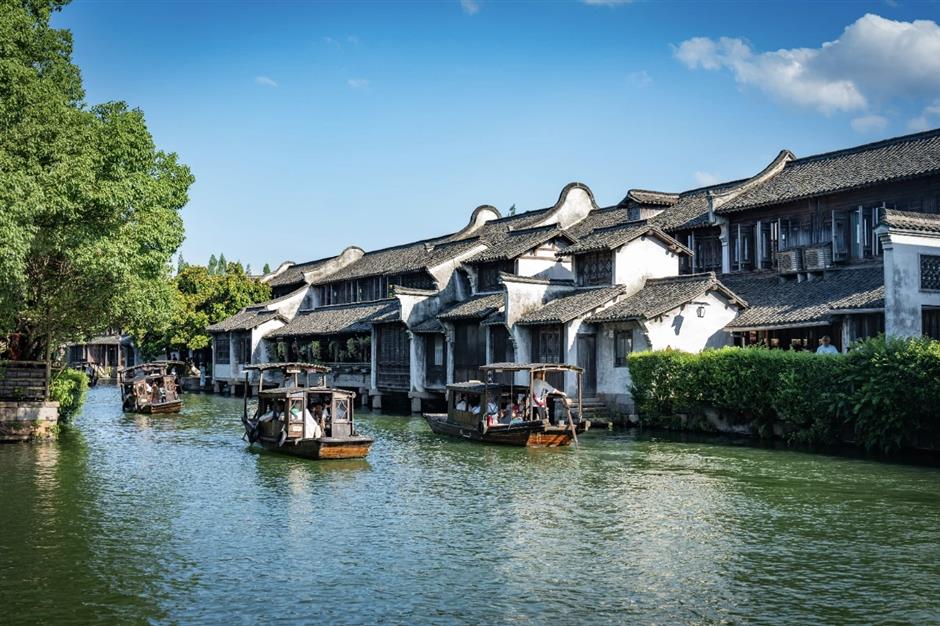
A view of Wuzhen.
The Dongzha scenic area is large, with a tour route of about 2 kilometers, consisting of Dongzha Old Street, Guanqian Street, riverside pavilions, and corridor sheds, allowing visitors to experience the quiet and graceful atmosphere unique to Jiangnan water towns.
It includes more than 20 attractions, such as Huiyuan Pawnshop, Fanglu Pavilion, Shadow Puppetry Hall, Mao Dun's Former Residence, Woodcarving Museum, and Blue Calico Dye Workshop.
Different from Dongzha, Xizha focuses on tourism and sightseeing and mainly serves business tourism and leisure vacations. With a vast area and crisscrossing rivers, Xizha has 72 ancient bridges, boasting the highest river density and number of stone bridges among ancient towns in China.
Its main attractions include Zhaoming Academy, Dingsheng Bridge, North Wetland, and Yuanbao Lake.
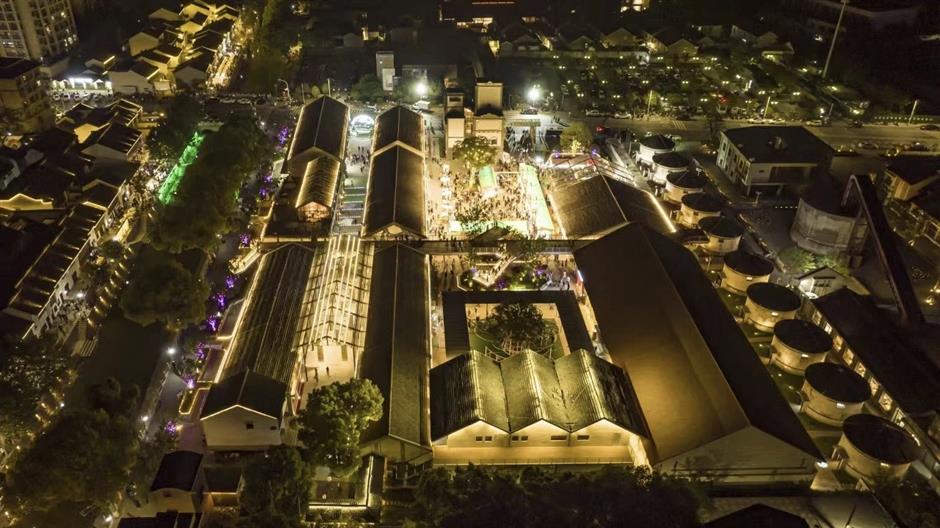
Glittering night view of Lianshi.
Lianshi 练市
Unlike Internet-famous ancient towns swarming with tourists, Lianshi Ancient Town preserves the most authentic Jiangnan flavor. The ancient canal flows quietly like a jade belt, and the cobblestone roads and old dwellings silently tell stories of the years. Every brick and stone here holds its own story.
It features small bridges, flowing water, and beautiful landscapes. The entire town is surrounded by an 18.6-kilometer ancient canal, like a long jade belt. With a history of over 2,000 years, it formed a market as early as the Qin and Han dynasties.
If you are looking for a tranquil place away from the urban treadmill, Lianshi is exactly the place. It's 130 kilometers from Shanghai, 60 kilometers from Hangzhou, and 80 kilometers from Suzhou – a paradise for self-driving travelers!
Jiutian Pavilion, Wenxing Bridge, and Shujie (Book Street) are like living history textbooks.
Lianshi is like a poem without flashy words. It lacks the commercial atmosphere of some other ancient towns, retaining only the purest image of a Jiangnan water town. Here, you can slow down, listen to the whispers of the cobblestone streets, and experience a unique, slow-paced life.
The mutton here is incredibly tender and juicy. Many foodies drive here just to have a bite of this local delicacy.
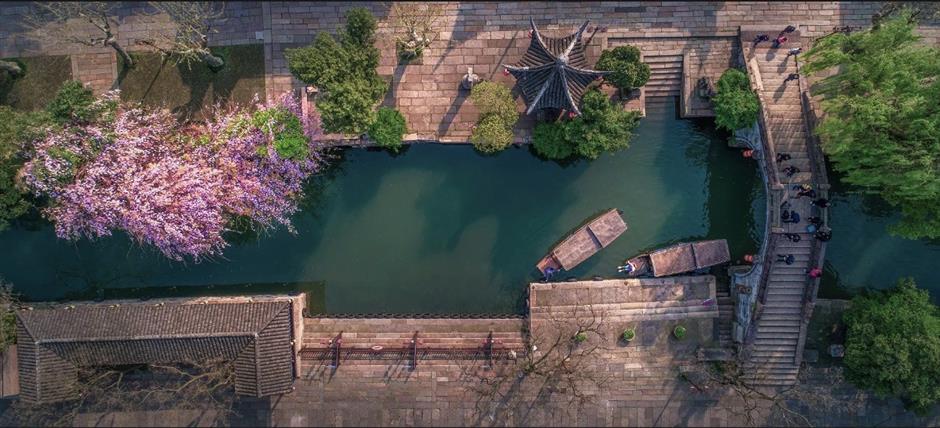
A bird's-eye of Nanxun.
Nanxun 南浔
Nanxun is like a long Jiangnan scroll slowly unfolding, blending the poetry of blue bricks, black tiles, stone bridges, flowing water, and sculling boats into time, fulfilling all dreams of a Jiangnan water town.
Walking through it feels like traveling through a thousand years, with every frame as picturesque as a poem.
A hidden gem from China's past, Nanxun Ancient Town is often called the "Silk Town of the Jiangnan Region." This charming town, dating back to the Ming and Qing dynasties, is the first of its kind in the Jiangnan region to be included in the World Cultural Heritage List.
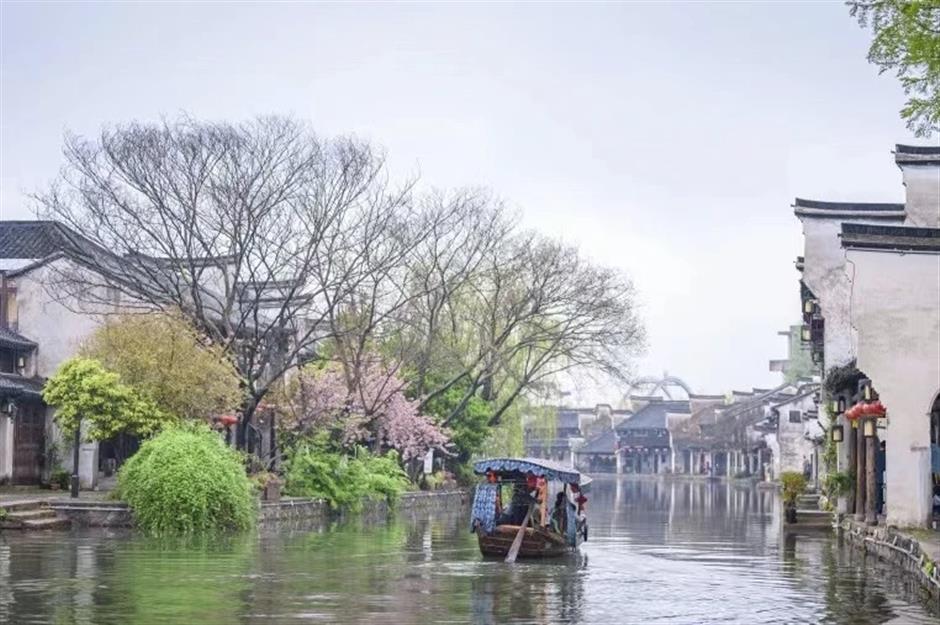
Nanxun boasts picturesque views.
Picture-perfect spots like Xiaolian Garden, Cangshu Lou, and Baijian Lou create a dreamy, watercolor-like scene. It's also a popular spot for traditional-style photoshoots.
Xiaolian Garden is located southwest of Wangu Bridge in Nanxun. It is a private garden founded in the 11th year of the Guangxu period of the Qing Dynasty (1885), and named Xiaolian in admiration of Lianhua Zhuang built by Zhao Mengfu, a great calligrapher and painter from Huzhou in the late Yuan Dynasty (1271-1368).
Jiaye Library is adjacent to Xiaolian Garden in the east. It features a Chinese-Western combined garden layout and a "口"-shaped corridor-style hall building. All wooden windows are hollow-carved with the seal characters "Jiaye Library." Outside the building are large garden, ponds, and rockeries.
Baijian Lou stretches about 400 meters from Dongdiao Bridge in the east to Shanzhuang Bridge in the north. Built along the river during the Wanli period of the Ming Dynasty by Dong Fen, a Nanxun native and Minister of Rites, it got its name from the hundred houses along the river and the long stone bridge connecting both banks.

